An Experimental Study on the Injection Characteristics and the Macroscopic Spray Characteristics of Rapeseed Oil-Diesel Fuel Blends
Abstract
1. Introduction
2. Materials and Methods
- —mass injection rate;
- Atube—cross-sectional area of the measuring tube;
- a—sound velocity in the fuel;
- m—injected fuel mass;
- p(t)—pressure variation.
3. Results and Discussion
3.1. Injection Rate Characteristics
3.2. Spray Characteristics
4. Conclusions
- Compared to diesel fuel, the peak volumetric injection rate of rapeseed oil was 22.0, 20.6, 11.3 and 9.1% lower by injection of the same amount of fuel at the injection pressure of 24.0, 40.0, 60.0 and 80.0 MPa, correspondently. Moreover, rapeseed oil and its blends with diesel fuel show a slower rise in the volumetric injection rate after the start of injection caused by its higher density and viscosity. Despite the higher density of rapeseed oil and its blend with diesel fuel, at low pressure, their mass flow rates remain lower than that of diesel fuel. The differences in maximum mass flow rates between diesel fuel, rape-seed oil and fuel blends become negligible at the higher injection pressures of 60.0 and 80.0 MPa due to about 10% higher density of RO that compensates for the lower volumetric flow rate.
- The spray development of RO demonstrates 26.9, 25.5, 14.0 and 7.4% longer tip penetration than diesel fuel at the injection pressures of 24.0, 40.0, 60.0 and 80.0 MPa after the same time after the start of injection (1 ms). The spray tip penetrations of the fuel blends RO25, RO50 and RO75 were arranged between the values of DF and RO. As the injection pressure increases the differences in the spray tip penetrations diminish.
- The spray cone angle of RO was 61.4%, 50.1%, 37.3% and 31.7% smaller than diesel fuel develops for the injection pressures of 24.0, 40.0, 60.0 and 80.0 MPa in the spray chamber. The fuel blends suggest smaller cone angles than diesel. The spray cone angles increase to maximum just after the start of injection and then decrease and stabilize around lower values.
- The spray area of RO is always 32.0–20.0% lower than that of diesel fuel and varies within a wide range of 300 to 400 mm2 while the spray area of diesel fuel less depends on the variation of injection pressure from 24.0 to 80.0 MPa and changes within a narrow range 460–500 mm2 for the same spray tip penetration of 50 mm. A smaller spray area would be expected to provide a poor distribution of RO droplets.
Funding
Institutional Review Board Statement
Informed Consent Statement
Data Availability Statement
Conflicts of Interest
Abbreviations
| CO2 | Carbon dioxide |
| GHG | Greenhouse Gases |
| FAME | Fatty Acid Methyl Esters |
| LCA | Life Cycle Assessment |
| DF | Diesel Fuel |
| RO | Rapeseed Oil |
| RO25 | 75% Diesel Fuel + 25% Rapeseed Oil |
| RO50 | 50% Diesel Fuel + 50% Rapeseed Oil |
| RO75 | 75% Diesel Fuel + 25% Rapeseed Oil |
| SOI | Start of Injection |
| STP | Spray Tip Penetration |
References
- Holden, N.M.; Wolfe, M.L.; Ogejo, J.A.; Cummins, E.J. Introduction to Biosystems Engineering; American Society of Agricultural and Biological Engineers (ASABE) and Virginia Technical Publishing: St. Joseph, MI, USA, 2021; Volume 3, pp. 154–196. [Google Scholar] [CrossRef]
- DIN 51605:2020-11; Kraftstoffe für Pflanzenöltaugliche Motoren—Rapsölkraftstoff—Anforderungen und Prüfverfahren/Fuels for Vegetable Oil Compatible Combustion Engines—Fuel from Rapeseed Oil—Requirements and Test Methods. DIN: Berlin, Germany, 2020; p. 18. [CrossRef]
- Fridrihsone, A.; Romagnoli, F.; Cabulis, U. Environmental life cycle assessment of rapeseed and rapeseed oil produced in Northern Europe: A Latvian case study. J. Sustain. 2020, 12, 5699. [Google Scholar] [CrossRef]
- Mizik, T.; Gyarmati, G. Economic and sustainability of biodiesel production—A systematic literature review. J. Clean Technol. 2021, 3, 19–36. [Google Scholar] [CrossRef]
- Lefebvre, A.H.; McDonell, V.G. Atomization and Sprays, 2nd ed.; eBook; CRC Press: Boca Raton, FL, USA, 2017; p. 300. [Google Scholar] [CrossRef]
- Han, D.; Duan, Y.; Wang, C.; Lin, H.; Huang, Z. Experimental study on injection characteristics of fatty acid esters on a diesel engine common rail system. Fuel 2014, 123, 19–25. [Google Scholar] [CrossRef]
- Vojtišek-Lom, M.; Pechout, M.; Barbolla, A. Experimental investigation of the behaviour of non-esterified rapeseed oil in a diesel engine mechanical fuel injection system. Fuel 2012, 97, 157–165. [Google Scholar] [CrossRef]
- Ettl, J.; Bernhardt, H.; Huber, G.; Thuneke, K.; Remmele, E.; Emberger, P. Evaluation of pure rapeseed oil as a renewable fuel for agricultural machinery based on emission characteristics and long-term operation behaviour of a fleet of 18 tractors. SN Appl. Sci. 2020, 2, 1711. [Google Scholar] [CrossRef]
- Aguado-Deblas, L.; Hidalgo-Carrillo, J.; Bautista, F.M.; Luna, C.; Calero, J.; Posadillo, A.; Romero, A.A.; Luna, D.; Estévez, R. Biofuels from Diethyl Carbonate and Vegetable Oils for Use in Triple Blends with Diesel Fuel: Effect on Performance and Smoke Emissions of a Diesel Engine. Energies 2020, 13, 6584. [Google Scholar] [CrossRef]
- Hanna, R.; Zoughaib, A. Atomization of high viscosity liquids through hydraulic atomizers designed for water atomization. Exp. Therm. Fluid Sci. 2017, 85, 140–153. [Google Scholar] [CrossRef]
- Galle, J.; Defruyt, S.; Van de Maele, C.; Rodriguez, R.P.; Denon, Q.; Verliefde, A.; Verhelst, S. Experimental investigation concerning the influence of fuel type and properties on the injection and atomization of liquid biofuels in an optical combustion chamber. Biomass Bioenergy 2013, 57, 215–228. [Google Scholar] [CrossRef]
- Das, M.; Sarkar, M.; Datta, A.; Santra, A.K. Study on viscosity and surface tension properties of biodiesel-diesel blends and their effects on spray parameters for CI engines. Fuel 2018, 220, 769–779. [Google Scholar] [CrossRef]
- Zhang, P.; Su, X.; Yi, C.; Chen, H.; Xu, H.; Geng, L. Spray, atomization and combustion characteristics of oxygenated fuels in a constant volume bomb: A review. J. Traffic Transp. Eng. 2020, 7, 282–297. [Google Scholar] [CrossRef]
- Xie, H.; Song, L.; Xie, Y.; Pi, D.; Shao, C.; Lin, Q. An Experimental Study on the Macroscopic Spray Characteristics of Biodiesel and Diesel in a Constant Volume Chamber. Energies 2015, 8, 5952–5972. [Google Scholar] [CrossRef]
- Ogunedo, M.B.; Nduaguba, K.C. Effect of Fuel Physical Properties on Spray Parameters of Residual Fuel Oil (RFO). IJRR Int. J. Res. Rev. 2019, 6, 448–456. [Google Scholar]
- Wang, Z.; Ding, H.; Wyszynski, M.L.; Tian, J.; Xu, H. Experimental study on diesel fuel injection characteristics under cold start conditions with single and split injection strategies. Fuel Process. Technol. 2015, 133, 213–222. [Google Scholar] [CrossRef]
- Payri, R.; Salvador, F.J.; Martí-Aldaraví, P.; Martínez-López, J. Using one-dimensional modeling to analyse the influence of the use of biodiesels on the dynamic behavior of solenoid-operated injectors in common rail systems: Detailed injection system model. Energy Convers. Manag. 2012, 54, 90–99. [Google Scholar] [CrossRef]
- Salvador, F.J.; Gimeno, J.; De la Morena, J.; Carreres, M. Using one-dimensional modeling to analyze the influence of the use of biodiesels on the dynamic behavior of solenoid-operated injectors in common rail systems: Results of the simulations and discussion. Energy Convers. Manag. 2012, 54, 122–132. [Google Scholar] [CrossRef]
- Bohl, T.; Tian, G.; Smallbone, A.; Roskilly, A.P. Macroscopic spray characteristics of next-generation bio-derived diesel fuels in comparison to mineral diesel. Appl. Energy 2017, 186, 562–573. [Google Scholar] [CrossRef]
- Ghurri, A.; Kim, J.-D.; Kim, H.G.; Jung, J.-Y.; Song, K.-K. The effect of injection pressure and fuel viscosity on the spray characteristics of biodiesel blends injected into an atmospheric chamber. J. Mech. Sci. Technol. 2012, 26, 2941–2947. [Google Scholar] [CrossRef]
- Boudy, F.; Seers, P. Impact of physical properties of biodiesel on the injection process in a common-rail direct injection system. Energy Convers. Manag. 2009, 50, 2905–2912. [Google Scholar] [CrossRef]
- Dernotte, J.; Hespel, C.; Foucher, F.; Houillé, S.; Mounaïm-Rousselle, C. Influence of physical fuel properties on the injection rate in a Diesel injector. Fuel 2012, 96, 153–160. [Google Scholar] [CrossRef]
- Labeckas, G.; Slavinskas, S. Performance of direct-injection off-road diesel engine on rapeseed oil. Renew. Energy 2006, 11, 849–863. [Google Scholar] [CrossRef]
- Shlegel, N.E.; Tkachenko, P.P.; Strizhak, P.A. Influence of viscosity, surface, and interfacial tensions on the liquid droplet collisions. Chem. Eng. Sci. 2020, 220, 115639. [Google Scholar] [CrossRef]
- Labeckas, G.; Slavinskas, S. Comparative evaluation of the combustion process and emissions of a diesel engine operating on the cetane improver 2-Ethylhexyl nitrate doped rapeseed oil and aviation JP-8 fuel. Energy Convers. Manag. X 2021, 11, 100106. [Google Scholar] [CrossRef]
- Payri, R.; Garcia, A.; Domenech, V.; Durrett, R.; Plazas, A.H. An experimental study of gasoline effects on injection rate, momentum flux and spray characteristics using a common rail diesel injection system. Fuel 2012, 97, 390–399. [Google Scholar] [CrossRef]
- Payri, F.; Bermu’dez, V.; Payri, R.; Salvador, J. The influence of cavitation on the internal flow and the spray characteristics in diesel injection nozzles. Fuel 2004, 83, 419–431. [Google Scholar] [CrossRef]
- Freitas, S.V.D.; Santos, Â.; Moita, M.-L.C.J.; Follegatti-Romero, L.A.; Dias, T.P.V.B.; Meirelles, A.J.A.; Daridon, J.-L.; Lima, Á.S.; Coutinho, J.A.P. Measurement and prediction of speeds of sound of fatty acid ethyl esters and ethylic biodiesels. Fuel 2013, 108, 840–845. [Google Scholar] [CrossRef]
- Wang, Z. Experimental Study on Diesel Spray with Single and Multiple Injection under Room Temperature and Low Temperature. Ph.D. Thesis, University of Birmingham, Birmingham, UK, 2015; p. 253. [Google Scholar]
- Postrioti, L.; Buitoni, G.; Pesce, F.C.; Ciaravino, C. Zeuch method-based injection rate analysis of a common-rail system operated with advanced injection strategies. Fuel 2014, 128, 188–198. [Google Scholar] [CrossRef]
- Ejim, C.E.; Fleck, B.A.; Amirfazli, A. Analytical study for atomization of biodiesels and their blends in a typical injector: Surface tension and viscosity effects. Fuel 2007, 86, 1534–1544. [Google Scholar] [CrossRef]
- Labeckas, G.; Slavinskas, S. Performance and exhaust emissions of direct-injection diesel engine operating on rapeseed oil and its blends with diesel fuel. In Transport: Journal of Vilnius Gediminas Technical University and Lithuanian Academy of Sciences; Technika: Vilnius, Lithuania, 2005; Volume 20, pp. 186–194. [Google Scholar]
- Bosch, W. The fuel rate indicator: A new instrument for display of the characteristic of individual injection. SAE Pap. 1966, 660749. [Google Scholar] [CrossRef]
- Balafoutis, A.; Fountas, S.; Natsis, A.; Papadakis, G. Performance and emissions of sunflower, rapeseed, and cottonseed oils as fuels in an agricultural tractor engine. Res. Artic. Int. Sch. Res. Netw. ISRN Renew. Energy 2011, 2011, 12. [Google Scholar] [CrossRef]
- Lamoot, L.; Manescau, B.; Chetehouna, K.; Gascoin, N. Review on the Effect of the Phenomenon of Cavitation in Combustion Efficiency, and the Role of Biofuels as a Solution against Cavitation. Energies 2021, 14, 7265. [Google Scholar] [CrossRef]

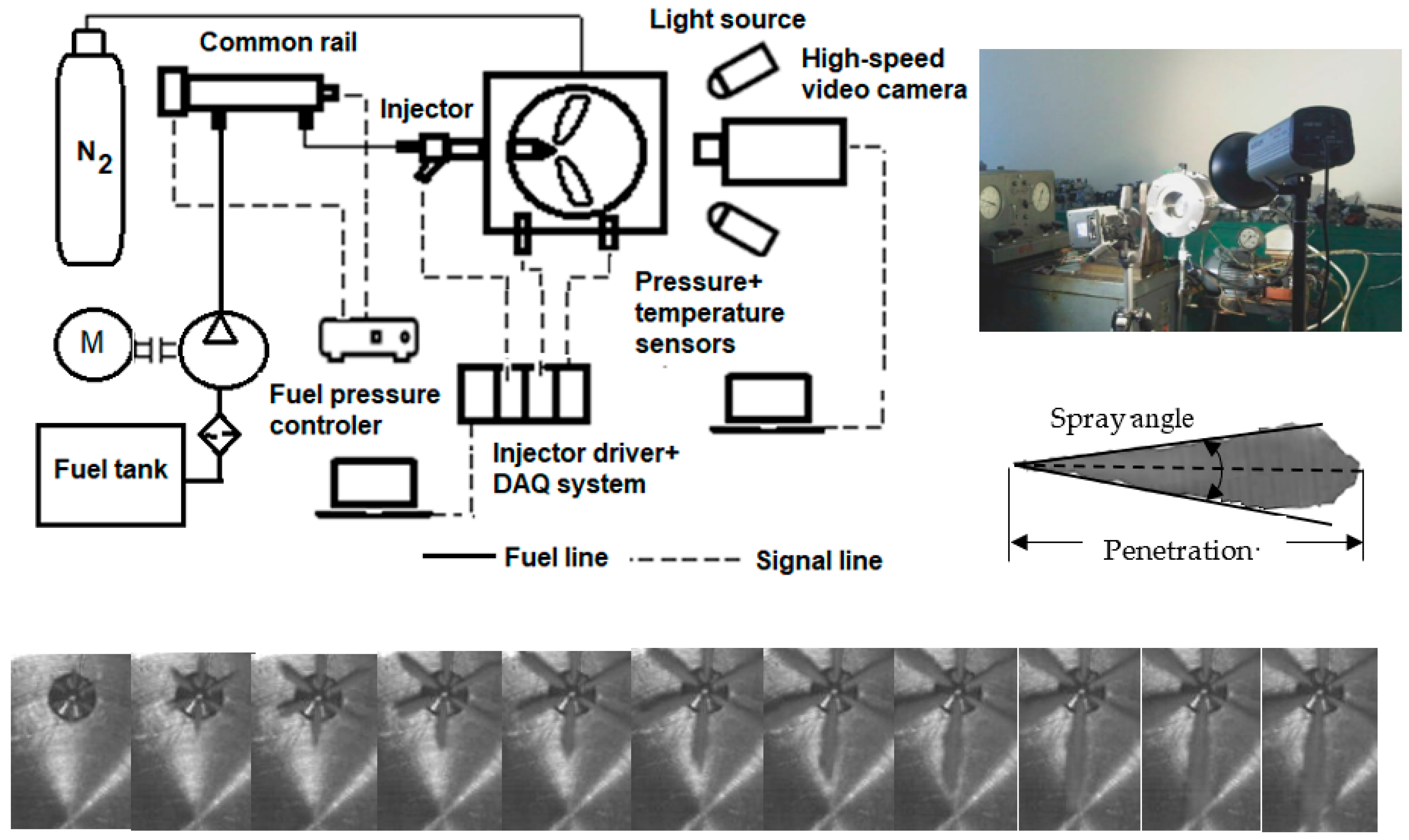
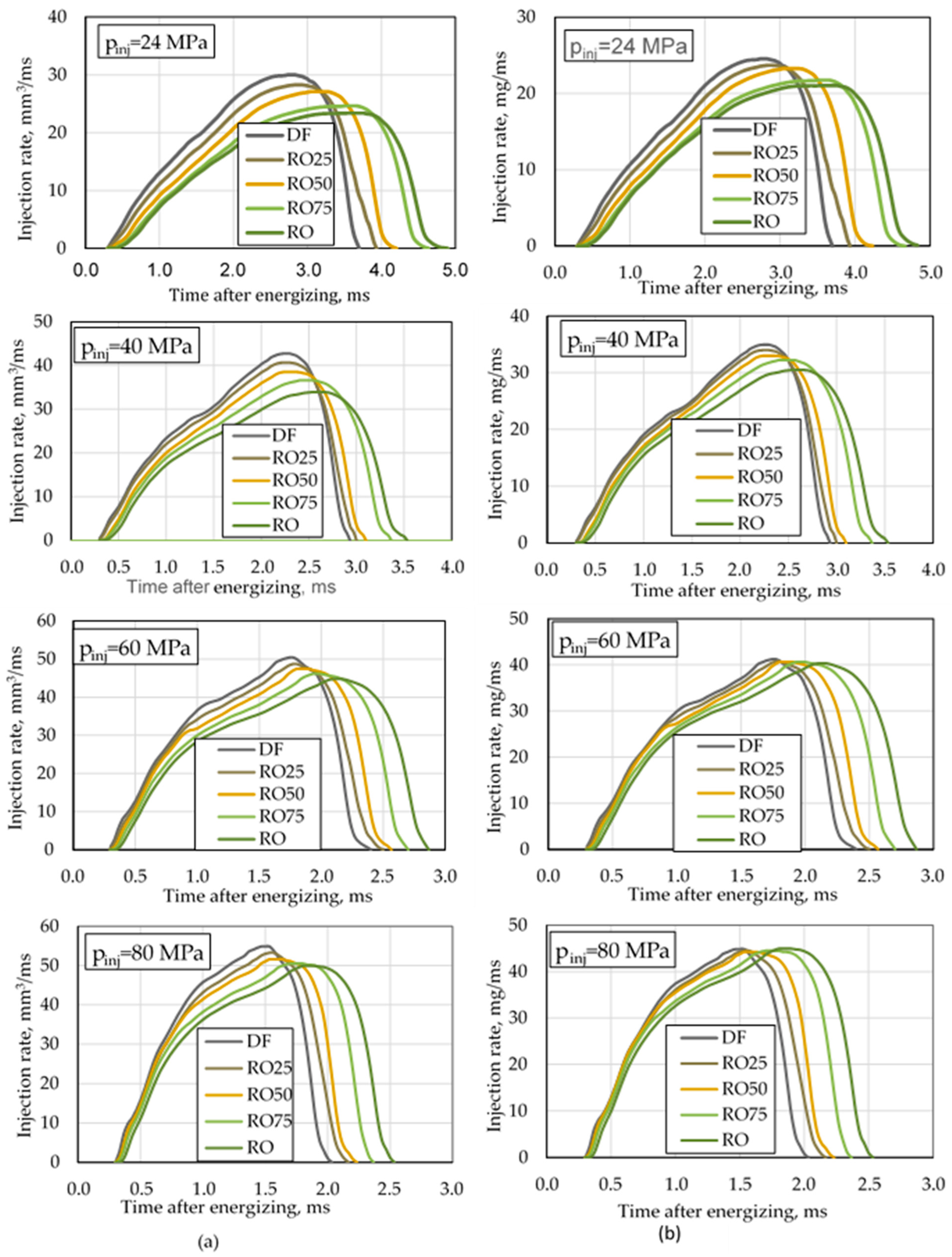
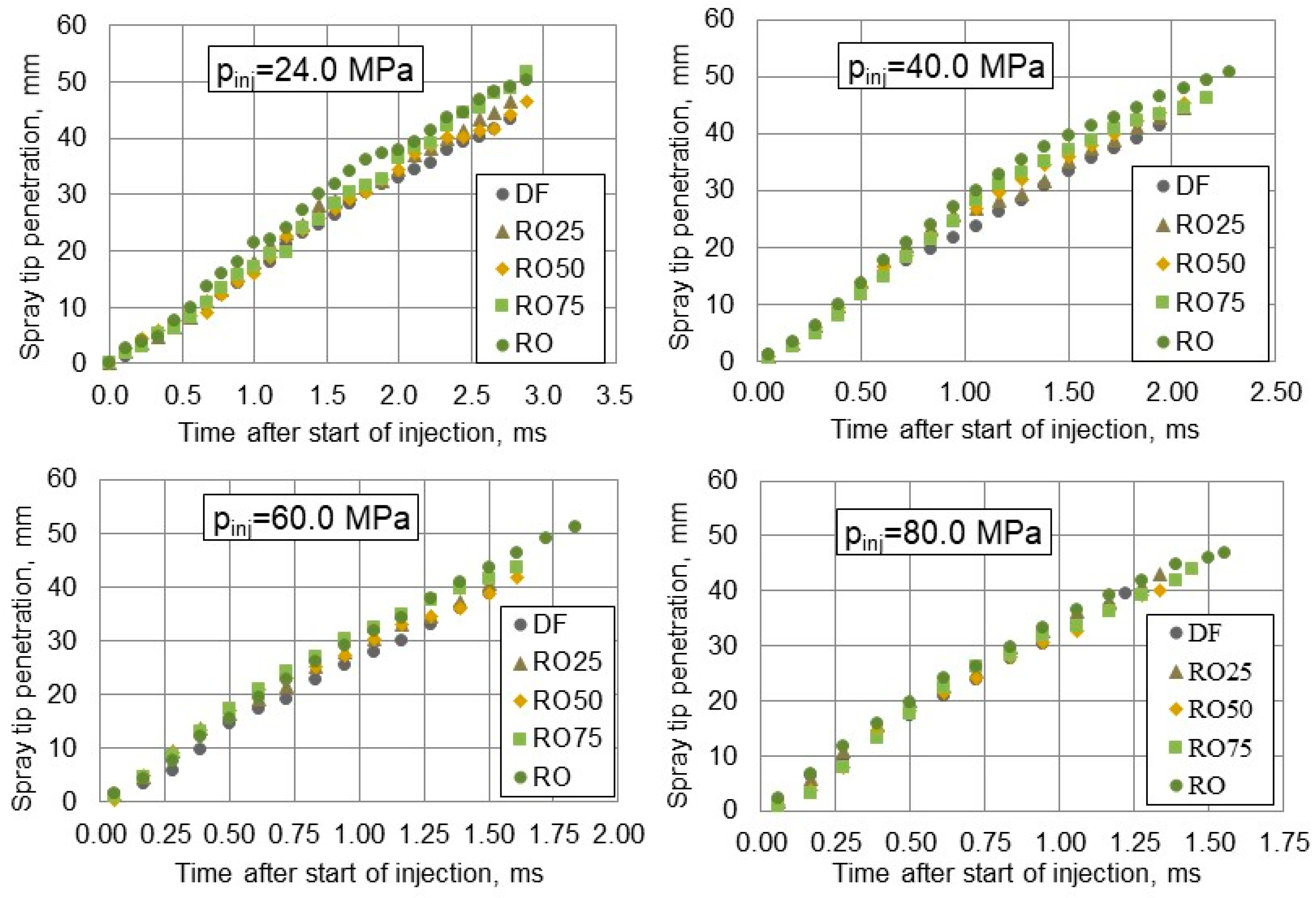
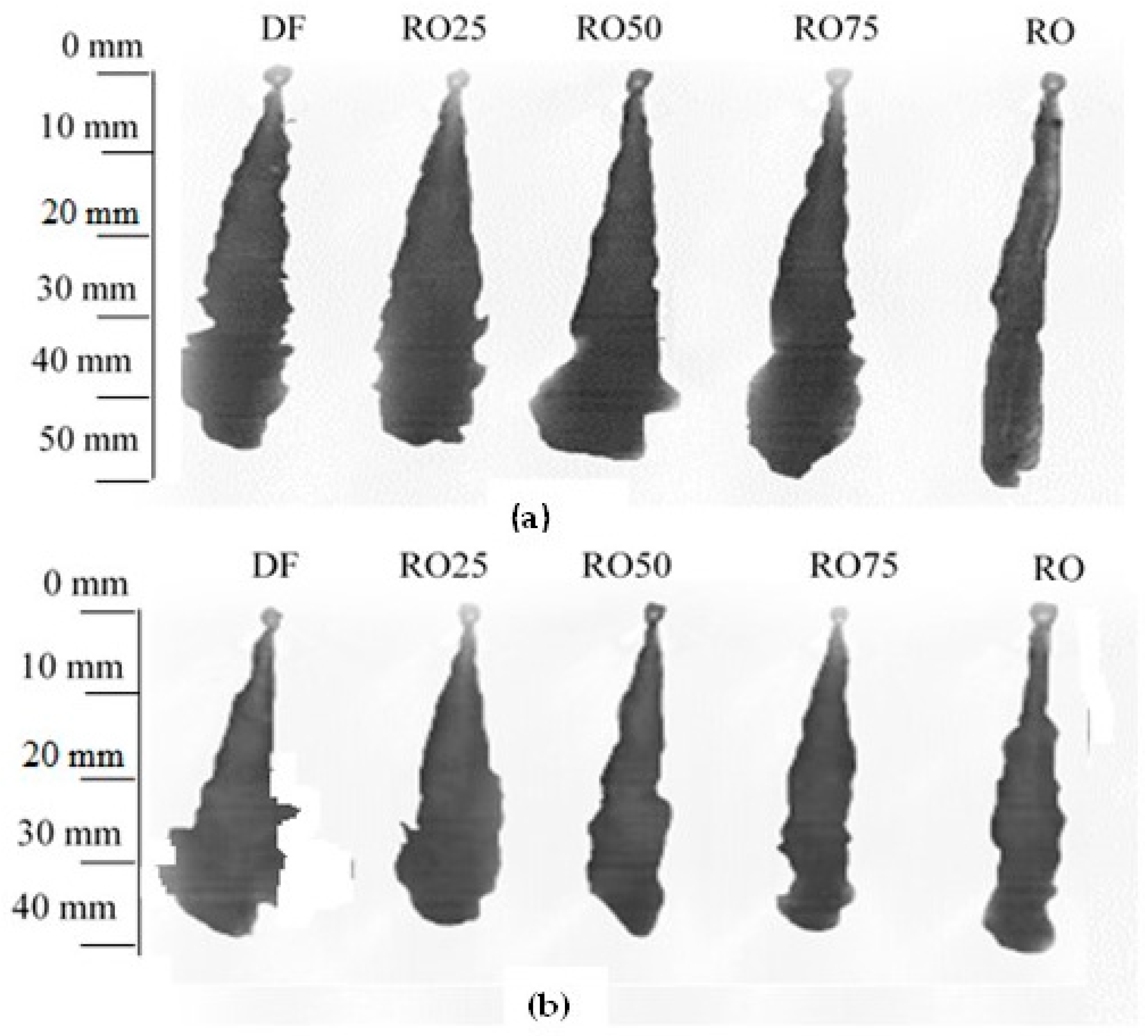
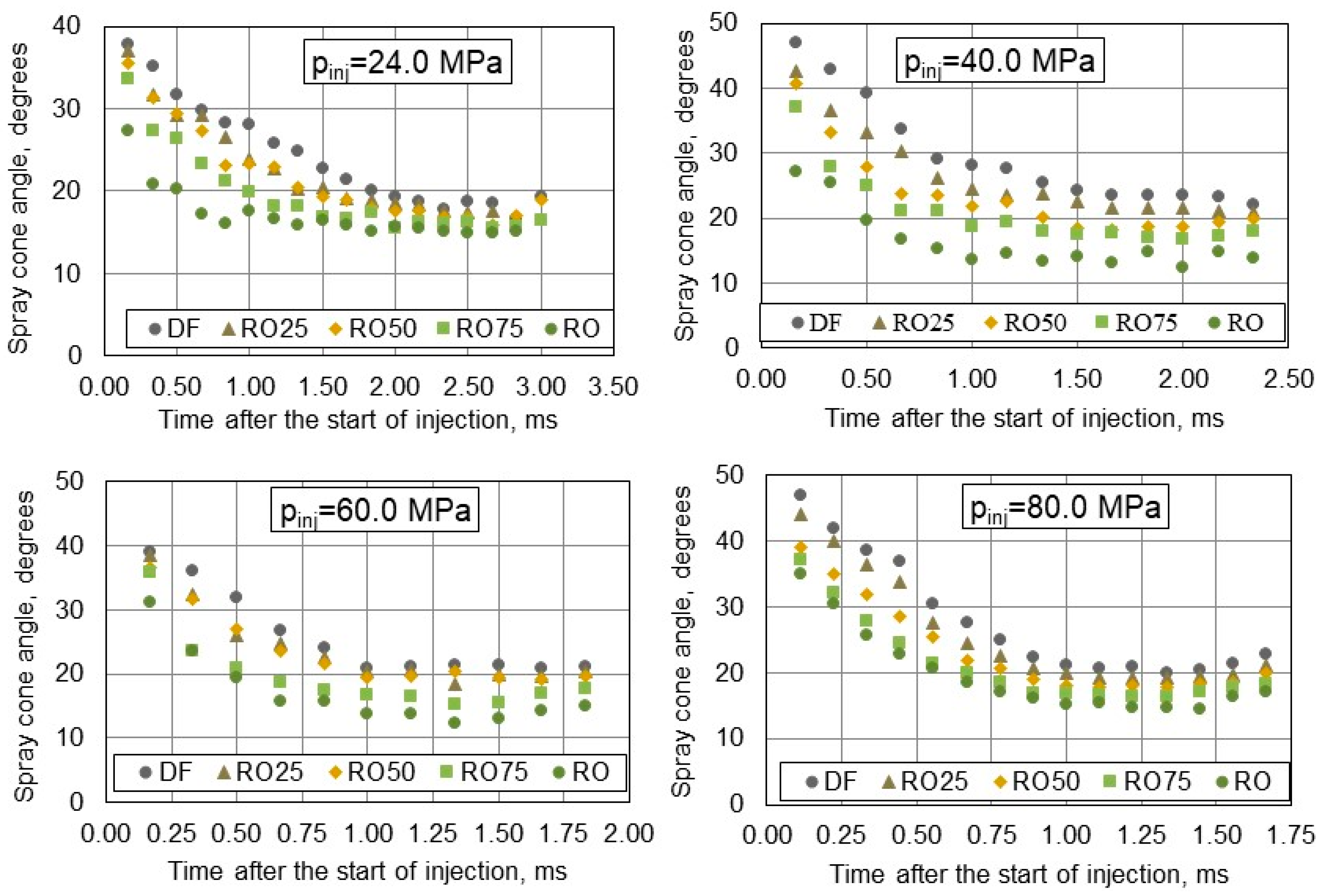
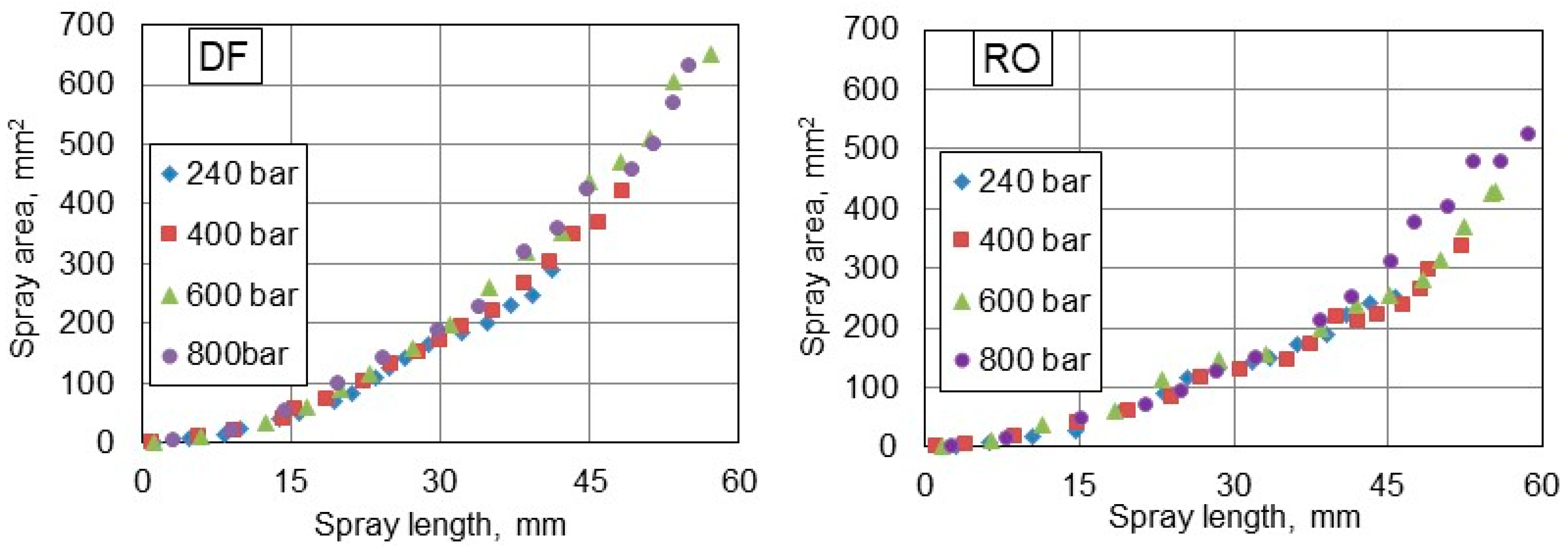
| Sr. No | Authors | Tested Fuels | Outcome |
|---|---|---|---|
| 1. | Han D. et al. [6], Payri R. et al. [17], Salvador F.J. et al. [18], Boundy F. et al. [21], Dernotte J. et al. [22] | Biodiesels | Effect of fuel properties on injection characteristics |
| 2. | Xie H. et al. [14], Bohl T. et al. [19], Ghurri A. et al. [20], Galle J. et al. [11] | Biodiesel | Effect of fuel properties on spray characteristics |
| 3. | Galle J. et al. [11], Das M. et al. [12] | RO, PO, Castor oil, sunflower oil | Effect of fuel properties on spray and atomization characteristics |
| 4. | Voijtišek-Lom M. et al. [7] | Crude rapeseed oil | Behaviour of DF and RO in tractor diesel engine with in-line injection pump |
| 5. | Ettl et al. [8] | Crude rapeseed oil | Diesel engine performance and durability |
| 6. | Zhang P. et al. [13] | Oxygenated fuels | Fuel spray and atomization characteristics |
| Fuel Properties | Diesel | RO25 | RO50 | RO75 | RO |
|---|---|---|---|---|---|
| Density at 15 °C, kg/m3 | 831.1 | 851.8 | 872.5 | 893.3 | 914.0 |
| Kinematic viscosity at 40 °C, mm2/s | 2.72 | 5.58 | 10.62 | 22.22 | 47.58 |
| Surface tension, mN/m | 36.0 | 41.2 | 46.7 | 52.4 | 57.8 |
| Injector Energizing Duration, ms | |||||
|---|---|---|---|---|---|
| Injection Pressure | DF | RO25 | RO50 | RO75 | RO |
| 24.0 MPa | 2.60 | 2.65 | 2.80 | 3.25 | 3.30 |
| 40.0 MPa | 1.85 | 1.50 | 2.00 | 2.10 | 2.20 |
| 60.0 MPa | 1.35 | 1.40 | 1.45 | 1.55 | 1.70 |
| 80.0 MPa | 1.10 | 1.20 | 1.25 | 1.30 | 1.40 |
| Standard Deviation, mg | |||||
|---|---|---|---|---|---|
| Injection Pressure | DF | RO25 | RO50 | RO75 | RO |
| 24.0 MPa | ±0.463 | ±0.730 | ±0.879 | ±0.906 | ±0.756 |
| 40.0 MPa | ±0.450 | ±0.712 | ±0.807 | ±0.901 | ±0.716 |
| 60.0 MPa | ±0.641 | ±0.779 | ±0.889 | ±0.868 | ±0.771 |
| 80.0 MPa | ±0.864 | ±0.836 | ±0.905 | ±0.904 | ±0.749 |
| Standard Deviation, mm | |||||
|---|---|---|---|---|---|
| Injection Pressure | DF | RO25 | RO50 | RO75 | RO |
| 24.0 MPa | ±1.145 | ±0.960 | ±0.665 | ±0.698 | ±0.716 |
| 40.0 MPa | ±1.196 | ±0.864 | ±1.121 | ±0.743 | ±0.785 |
| 60.0 MPa | ±0.826 | ±0.718 | ±0.839 | ±1.094 | ±0.873 |
| 80.0 MPa | ±0.735 | ±1.124 | ±0.824 | ±0.677 | ±0.670 |
Disclaimer/Publisher’s Note: The statements, opinions and data contained in all publications are solely those of the individual author(s) and contributor(s) and not of MDPI and/or the editor(s). MDPI and/or the editor(s) disclaim responsibility for any injury to people or property resulting from any ideas, methods, instructions or products referred to in the content. |
© 2023 by the author. Licensee MDPI, Basel, Switzerland. This article is an open access article distributed under the terms and conditions of the Creative Commons Attribution (CC BY) license (https://creativecommons.org/licenses/by/4.0/).
Share and Cite
Slavinskas, S. An Experimental Study on the Injection Characteristics and the Macroscopic Spray Characteristics of Rapeseed Oil-Diesel Fuel Blends. Appl. Sci. 2023, 13, 5944. https://doi.org/10.3390/app13105944
Slavinskas S. An Experimental Study on the Injection Characteristics and the Macroscopic Spray Characteristics of Rapeseed Oil-Diesel Fuel Blends. Applied Sciences. 2023; 13(10):5944. https://doi.org/10.3390/app13105944
Chicago/Turabian StyleSlavinskas, Stasys. 2023. "An Experimental Study on the Injection Characteristics and the Macroscopic Spray Characteristics of Rapeseed Oil-Diesel Fuel Blends" Applied Sciences 13, no. 10: 5944. https://doi.org/10.3390/app13105944
APA StyleSlavinskas, S. (2023). An Experimental Study on the Injection Characteristics and the Macroscopic Spray Characteristics of Rapeseed Oil-Diesel Fuel Blends. Applied Sciences, 13(10), 5944. https://doi.org/10.3390/app13105944








